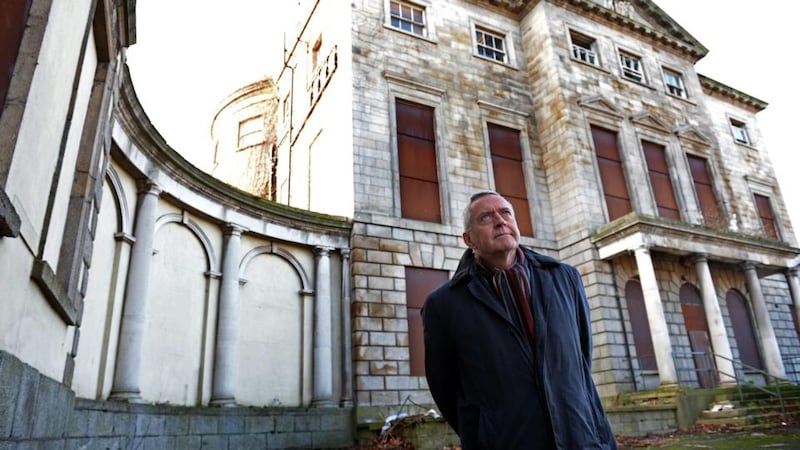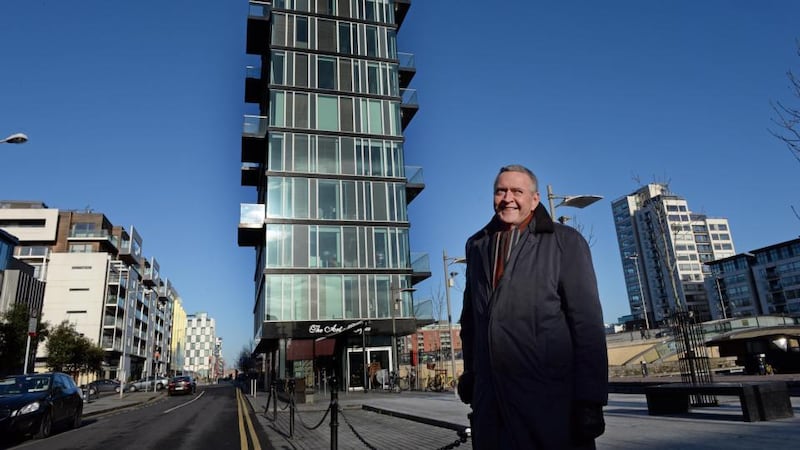The heart of Dublin was so riddled by urban blight 40 years ago that one former Lord Mayor (the late Jim Mitchell, of Fine Gael) complained that it had "about as much character as a second-rate knacker's yard". The city was in such a bad way that it desperately needed to be rescued; otherwise, the game was up.
Those who didn’t live through the era can barely imagine how bleak Dublin was in late 1970s, when I started writing about it. There were derelict sites everywhere, including the Liffey quays, lots of dilapidated buildings boarded up for demolition and a general air of decay fostered by official ineptitude and political neglect.
I reckoned that there was a story behind every hoarding and set about finding out what was going on. From this original research in Dublin Corporation’s planning and roads departments, the Land Registry and the Companies Office emerged a rogue’s gallery of developers, speculators, architects and roads engineers.


There was a book in it, Gill & Macmillan thought. So the whole sordid story – or as much of it as we could commit to print – was told in The Destruction of Dublin, published in November 1985. It was widely reviewed, even by Hot Press, and became an instant best-seller but couldn't be reprinted due to a small raft of threatened libel actions.
A real turning point was the Dublin Crisis Conference that packed the old Synod Hall at Christchurch Place for a whole weekend in February 1986. It called on the government and the Dublin local authorities to “recognise and accept that the city is in crisis”, and the radical changes in public policy we demanded then have nearly all since happened.
Youthful activists, notably Students Against the Destruction of Dublin, took the discussion out of drawingrooms and relatively polite meetings into the streets – occupying threatened buildings, staging well-flagged protests and acting as shock troops against road-widening schemes that had done so much damage to the inner city’s fabric.
Like the late Deirdre Kelly, founder of the Living City Group, those of us campaigning to save Dublin realised that its future depended on reversing the relentless depopulation of inner city. So we set about changing public perceptions of the core to promote it as a place to live rather than just a business district surrounded by ghettos.
Back in 1986, regional planners didn’t see any hope that the inner city could accommodate even an extra 10,000 people. Since then, aided by tax incentives and a wish among the younger generation to live closer to where they work, its population has risen by more than 60 per cent – with huge spin-offs in terms of jobs in cafés, delis and local shops.
Dame Street, for example, was a dark thoroughfare in the 1980s, with only the Olympia Theatre to liven it up, and the discreet presence of Nico’s and Les frères Jacques. Now, it’s lined by restaurants of every hue and convenience stores such as Centra and Spar that don’t even have doors because they’re open 24 hours per day, 365 days per year.
But we spent a long time feeling our way towards new forms of urban living, unable at first to see beyond shoebox apartments with three-quarter-scale furniture and no storage, laid out on either side of long artificially-lit corridors, before finally catching up with the generous spatial standards that apply in most other European capitals.
After decades of sameness, all drab shades of grey, Dublin became colourfully cosmopolitan and we discovered from the 2006 census that at least 10 per cent of the population were foreign nationals. These "New Irish" became the mainstay of Dublin Bus services while many of the native Irish shunned public transport in favour of flashy cars.
Immigrants patronised public parks while we went shopping in new malls like Dundrum, with its six floors of underground parking. Luas trams appealed to us, with a marked preference for the Green line over the Red one; they didn’t join up because Bertie Ahern’s coalition government hadn’t the guts to take more road space from cars.
Neither did Ahern do anything to curtail the leapfrogging of Dublin all over Leinster, as the city's commuter belt spread obesely outwards to a radius of 100km. The M50 was barely finished when it had to be extended to six lanes, with all of the interchanges reconfigured to cater for ever-growing volumes of traffic, at a cost of €1 billion.
More recent tweaks include a new flyover at Newlands Cross, but we have yet to see any progress being made on plans for cross-city busways or the strategically important Dart Underground – a tunnel that would run from Heuston via St Stephen’s Green and Pearse Station to Spencer Dock, integrating all suburban rail services.
And just when it seemed that bicycles were passé, they underwent a spectacular revival thanks to the cycle-to-work tax incentive – an initiative by the Green Party in government – and the introduction of Dublin Bikes; this Labour-inspired scheme now has 50,000 annual subscribers and caters for up to 15,400 journeys per day.
The built environment was also a winner. Years ago, nobody needed planning permission in advance to pull down historic buildings, so it's no wonder that such a large number disappeared. That changed in 1999 when we belatedly adopted preservation laws comparable to the rest of Europe – but without the back-up of generous funding.
Archer’s Garage on Fenian Street, a rare art deco piece illegally demolished over the June bank holiday weekend in 1999, had to be rebuilt, more or less in facsimile. But Aldborough House, the last great Georgian-era mansion built in Dublin, is rotting away on Portland Row after years of dereliction and abortive plans for refurbishment.
Not far away is the International Financial Services Centre, arranged around the Custom House Docks – an incredible development by any standard, particularly for the previously neglected northside. Of course, it spread south all along Sir John Rogerson’s Quay and around the Grand Canal Docks – now very emphatically the “new Dublin”.
The hype surrounding the Temple Bar project was more outlandish, suggesting that the city's officially-designated cultural quarter would become Dublin's answer to Covent Garden in London. Instead, it turned into "the temple of bars", and was branded last April by the Huffington Post as a place that "should be avoided at all costs".
During the boom years, Dublin nearly fell victim to a mania for tall buildings that would have sprung up in Docklands, around Heuston Station and right in the heart of Ballsbridge. Senior city officials wanted to see it happen, even encouraging certain developers to aim higher, but the line was held by An Bord Pleanála (with few exceptions).
The property crash and recession put on ice all of these high-rise plans, which included the U2 Tower on Britain Quay and Harry Crosbie’s Watchtower in the Point Village, just across the river; they were to be the joint sentinels of Dublin.
In the meantime, we’ll have to make do with its existing markers – the striped Poolbeg stacks.
Another major project that mercifully didn’t materialise was the national stadium, or “Bertie Bowl”, at Abbotstown, off the M50. Instead we ended up with a redeveloped Lansdowne Road for rugby and soccer, to complement the GAA’s great amphitheatre on Jones’s Road – both grounds within easy walking distance from the city centre.
For the most part, Dublin remains "the centre of paralysis", as James Joyce once diagnosed it. Plans are drawn up, visions spelled out and mission statements enunciated, but nothing much happens. Too many agencies have their fingers in the civic pie, and Dublin City Council – which should be in charge – is left to fight the inevitable turf wars.
That’s why we need a directly elected mayor with executive powers – and the sooner the better. Because Dublin is the only Irish city with critical mass to compete for inward investment by the likes of Google, Intel and the rest. To succeed, however, its priority must be to develop a public transport system that’s truly worthy of a European capital.
Living in an uncivil society, it really is the little things that get to you
In Dublin, so many things are regarded as normal that simply aren’t normal by any civilised standard. Taken together, what all of these deviances seem to suggest is that we’re just down out of the trees in terms of developing urban sensibilities.
I’m not just talking about motorists who casually break red lights at pedestrian crossings, or those who are utterly convinced that they have the right of way over pedestrians when turning into a side street when they patently don’t.
This isn’t about about cyclists who think nothing of pedalling on footpaths, up one-way streets in the wrong direction and across the Millennium Footbridge, weaving through waves of pedestrians. Or about how chaotically we walk in congested areas.
It’s also got nothing to do with the insultingly short time we’re given to cross a street and the fact that every push-button signal in the city centre (with the sole exception of Kildare Street, outside Leinster House) is merely a placebo, giving an illusion of control.
We have no concept of the public realm either.
It’s a place to be littered, urinated in, “tagged” with graffiti or polluted with noise from heavily amped speakers attached to pubs, shops, cafes or rock bands performing in Grafton Street and Temple Bar.
When we put out recyclable stuff for collection, it wouldn’t be unusual for the green bin full of bottles to be upended into the street by drunken gurriers – just for fun – or for passers-by to dump their own decaying garbage in our dry recyclables bin.
There’s no proper maintenance of public facilities. The bronze handrails and stainless steel lamp standards on the Millennium Bridge are repeatedly targeted by graffiti taggers and fly-posting vandals, precisely because of its haphazard cleaning regime.
The 12 gas braziers in Smithfield haven’t been lit for years, so what’s the point of having them? Similarly, why bother replacing seriously scarred glass panels on the seats along Grattan Bridge with new frosted ones if you’re not going to keep them clean?
The only sign of civility is the charming Dublin practice of saying thanks to bus drivers before hopping off. But if we really cared about public transport, Luas trams would have priority at every junction and we’d shave five minutes off the journey time to Tallaght.












